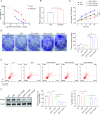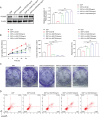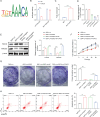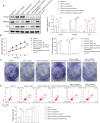Shenqifuzheng injection inhibits lactic acid-induced cisplatin resistance in NSCLC by affecting FBXO22/p53 axis through FOXO3
- PMID: 39487426
- PMCID: PMC11531113
- DOI: 10.1186/s12931-024-03013-8
Shenqifuzheng injection inhibits lactic acid-induced cisplatin resistance in NSCLC by affecting FBXO22/p53 axis through FOXO3
Abstract
Background: Non-small cell lung cancer (NSCLC) accounts for 80% of lung cancers. Cisplatin (DDP)-based combination chemotherapy is the main treatment of NSCLC. Due to resistance to DDP, 5-year overall survival rate of NSCLC patients is very low. Shenqifuzheng injection (SQFZ) is essential for lung cancer progression. However, whether SQFZ plays a role in DDP resistance in NSCLC and its molecular mechanism remains unclear.
Methods: Levels of FOXO3, FBXO22 and p53 in NSCLC tissues and cells were assessed by RT-qPCR and Western blot. Cell proliferation and apoptosis were analyzed utilizing CCK-8, Colony formation and Flow cytometry assays. Lactate (LA) levels were tested via ELISA. ChIP and Dual luciferase reporter assays validated regulatory relationship between FOXO3 and FBXO22. Immunoprecipitation assay evaluated p53 ubiquitination levels. The subcutaneous tumor model of nude mice was constructed. TUNEL staining detected apoptosis in tissues, and IHC assessed expression of Ki67, FOXO3, FBXO22 and p53.
Results: FOXO3 was decreased, whereas LA and FBXO22 were increased in NSCLC patients. LA led to a higher DDP resistance in A549/DDP cells, while SQFZ reversed this effect by upregulating FOXO3. Furthermore, FBXO22 was a downstream effecter of FOXO3 and FBXO22 affected p53 ubiquitination to reverse the inhibitory effect of SQFZ. We next found SQFZ inhibited LA-induced DDP resistance in NSCLC via FOXO3/FBXO22/p53 axis. Finally, SQFZ regulated LA-mediated DDP resistance in NSCLC nude mice.
Conclusion: SQFZ influences LA-induced DDP resistance in NSCLC via FOXO3/FBXO22/p53 pathway, providing a promising agent for NSCLC treatment.
Keywords: Cisplatin resistance; FBXO22; FOXO3; Non-small cell lung cancer; Shenqifuzheng injection; p53.
© 2024. The Author(s).
Conflict of interest statement
The authors declare no competing interests.
Figures







References
-
- Herbst RS, Morgensztern D, Boshoff C. The biology and management of non-small cell lung cancer. Nature. 2018;553(7689):446–54. - PubMed
-
- Zou J, Zeng Y, Wu F. Opportunities and challenges of neoadjuvant targeted therapy in nonsmall cell lung cancer. Curr Opin Oncol. 2023;35(1):22–30. - PubMed
-
- Zeng Y, et al. Resistance mechanisms to osimertinib and emerging therapeutic strategies in nonsmall cell lung cancer. Curr Opin Oncol. 2022;34(1):54–65. - PubMed
MeSH terms
Substances
Grants and funding
LinkOut - more resources
Full Text Sources
Medical
Research Materials
Miscellaneous

